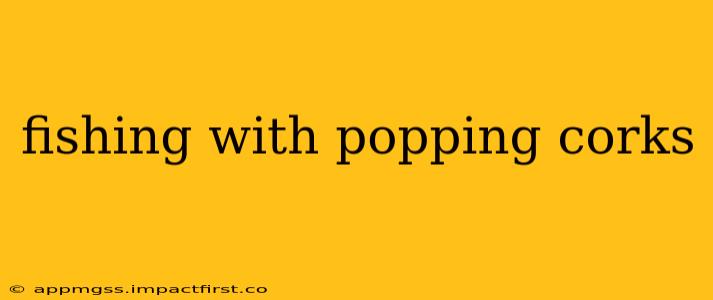Popping corks, also known as popping floats or popping bugs, are versatile fishing lures that create a unique surface disturbance, attracting predatory fish with their erratic action. This guide dives deep into the art of fishing with popping corks, covering everything from choosing the right gear to mastering effective techniques. Whether you're a seasoned angler or a beginner, this comprehensive guide will enhance your fishing skills and increase your chances of a successful catch.
What are Popping Corks?
Popping corks are buoyant fishing floats designed to sit on the water's surface. Their distinctive feature is their hollow design and often brightly colored bodies which, when retrieved with a sharp jerk, create a distinct "pop" sound and splash, mimicking the distress calls of injured baitfish. This action is incredibly effective in attracting predatory fish like bass, redfish, snook, and trout, who are drawn to the commotion.
How to Choose the Right Popping Cork
Selecting the appropriate popping cork depends heavily on the target species, water conditions, and fishing style.
Size: Larger popping corks are generally better suited for larger fish and deeper water, while smaller corks are ideal for smaller fish and shallower water.
Weight: The weight of the popping cork influences its casting distance and how easily it can be worked. Heavier corks cast further but may be less sensitive to subtle strikes.
Shape and Design: Various designs offer different actions. Some have a more pronounced popping sound than others, while certain shapes are better suited for specific retrieval techniques.
Color: Color selection is crucial, and often depends on water clarity and the time of day. Bright colors are great in stained or murky water, while more subdued colors work well in clear water.
What are the best hooks to use with popping corks?
The hook choice for popping corks depends largely on the bait you intend to use and the size of the fish you anticipate catching. Generally, you'll want a hook that is strong enough to handle the potential strain of a sizable fish but not so large that it overwhelms your bait or deters fish from biting.
- Live Bait: For live bait like shrimp or minnows, consider using a light-wire hook like a #2 or #4 circle hook or octopus hook. These hooks are designed for better hook-ups and are less likely to tear the bait.
- Artificial Bait: When employing artificial lures like soft plastics or small swimbaits, a size 1/0 to 3/0 hook, depending on the size of the lure, will usually suffice. Consider using a hook with a wide gap for better hooking power.
How do you rig a popping cork?
There are several effective ways to rig a popping cork, each offering slightly different presentations. The most common methods include:
- Texas Rig: Ideal for weedless applications, you simply thread your line through the cork, add a weight if necessary, and attach your hook.
- Carolina Rig: This setup is best for covering significant distance and is great in deeper waters, employing a weight and leader to allow the bait to suspend freely.
- Float Rig: Using a specialized float stop, this method allows for adjusting the bait's depth beneath the cork.
What is the best way to fish with a popping cork?
The key to successfully fishing with a popping corks is mastering the retrieve. This is achieved by short, sharp tugs of the rod tip that create the characteristic popping sound and erratic movement.
- Retrieve: A series of short, sharp twitches of your rod followed by a brief pause will mimic a struggling baitfish.
- Pauses: Allowing pauses during your retrieve can often trigger a strike, giving the fish a chance to react.
- Varying the retrieve: Don’t be afraid to experiment with your retrieve speed and intensity to discover what works best in different conditions.
What kind of fish can you catch with a popping cork?
Popping corks are extremely versatile and attract a wide array of predatory fish. Some of the most common include:
- Largemouth Bass: A staple for popping cork fishing.
- Redfish: An excellent choice for targeting these hard-fighting fish in shallow coastal waters.
- Snook: Popping corks are a productive way to catch snook in inshore environments.
- Trout: Effectively used in both freshwater and saltwater environments.
What is the best time of day to fish with a popping cork?
While popping corks can be effective throughout the day, they’re particularly productive during low-light conditions, such as dawn and dusk. During these times, the fish are often more active and visually oriented, making the popping cork’s commotion a powerful attractant.
What types of water are best for popping corks?
Popping corks shine in shallower, calmer waters where their action is most visible and effective. Areas with abundant vegetation or structure are also excellent locations, as fish will often ambush prey from these cover spots.
This comprehensive guide offers a strong foundation for mastering the art of popping cork fishing. Remember that practice and experimentation are crucial to refining your technique and finding what works best in different conditions. Tight lines!
